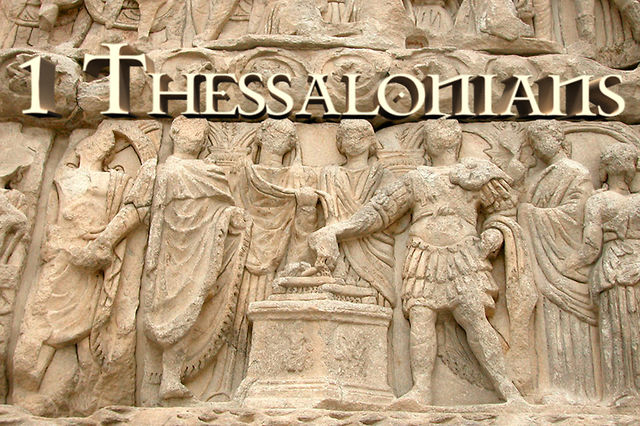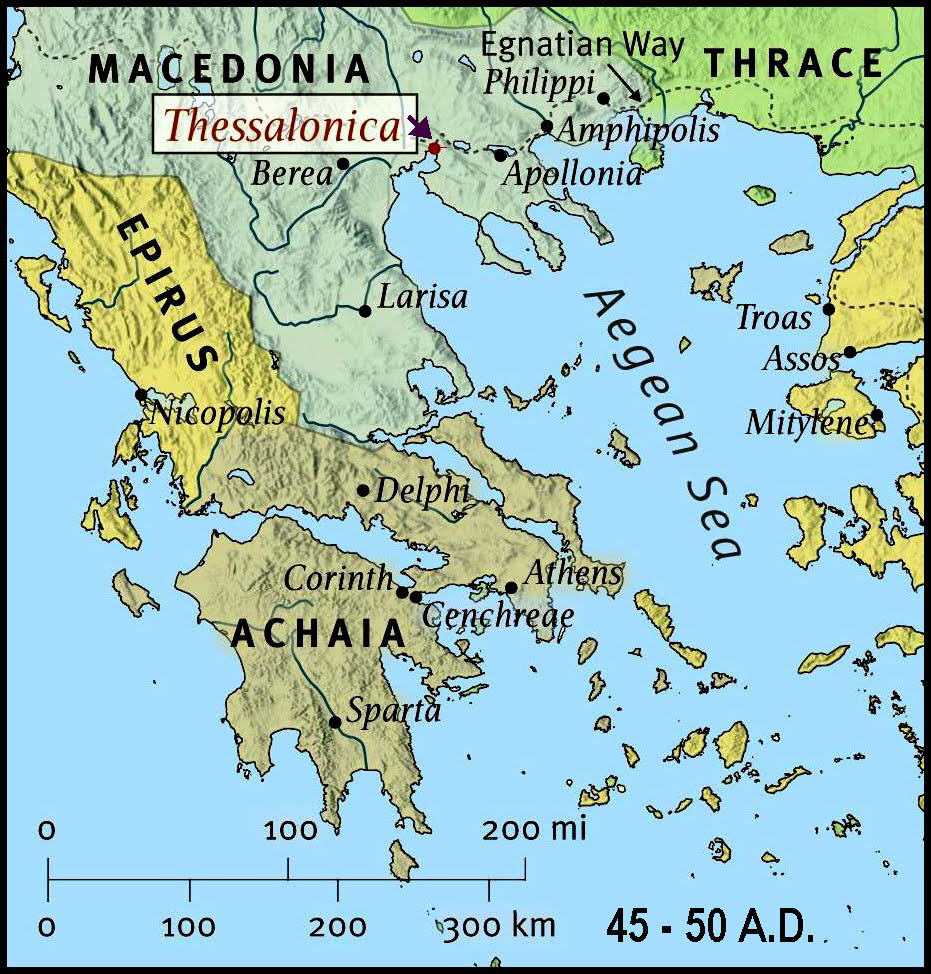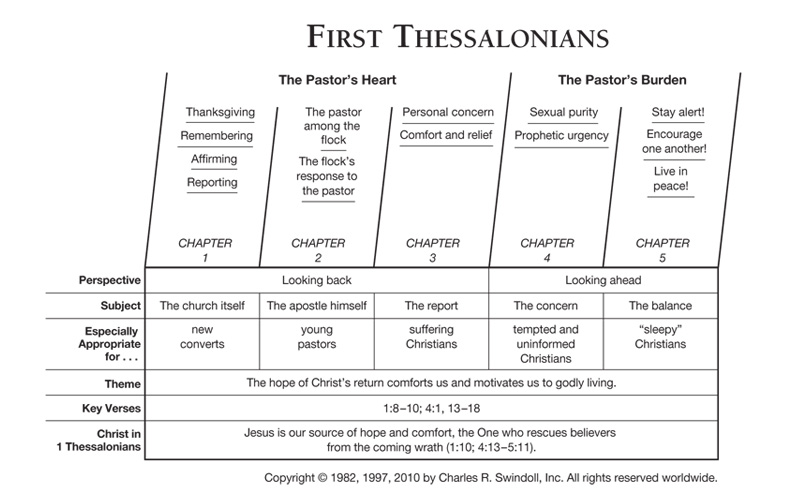1 THESSALONIANS INTRODUCTION

A COMMENTARY DEVOTIONAL STUDY OF
1 THESSALONIANS
INTRODUCTION
By Michael K. Farrar, O.D.
© God’s Breath Publications
Biblical devotionals, if properly done, are very helpful to us in growing spiritually and living out our faith. But they are only as good as they are applied to our everyday lives. Charles Swindoll says it this way,
“Knowledge apart from application falls short of God’s desire for His children.He wants us to apply what we learn so that we will change and grow.”
While the Holy Spirit’s ministry is to grow us spiritually, we also have a responsibility in the growth of our spiritual life. One of the first steps we can take in the process of spiritual growth is to know more of the Word of God (2 Timothy 2:15). Our spiritual faith can mature and grow in depth when our knowledge of the Word increases. This can give us a greater confidence in our Heavenly Father and empower us to live our life modeled after our Lord and Savior, Jesus Christ. But with greater knowledge of the Word comes a greater responsibility, that of applying ourselves to living what we know and trusting God in our decisions and behavior. To assist us in this challenge God has given us the Holy Spirit who lives within us as a guide, encourager and convictor.
Scriptural knowledge must not just be accumulated, it must be applied to how we think, act and live. As we seek to apply what we know of God’s Word we will see an increase in our obedience to the Holy Spirit’s instruction which demonstrates our love for God (John 14:15). As we continue to apply what we learn, we walk as Jesus walked (1 John 2:6) and keep in step with the Holy Spirit more consistently (Galatians 5:25). Out of this right thinking and correct application we experience a godly joy that is present, even in trials and tribulations (1 Thessalonians 1:6).
In this devotional series I hope to both encourage you in your relationship with God, but also challenge you to apply what you learn from God’s Word. The New Testament book of James commands us to be doers of the word (James 1:22-25). In other words, we MUST APPLY what we read and learn if we are to fulfill our calling, to think, act and walk as our Savior and Lord, Jesus Christ.
James 1:22-25
“Prove yourselves doers of the word, and not merely hearers who delude themselves. For if anyone is a hearer of the word and not a doer, he is like a man who looks at his natural face in a mirror; for once he has looked at himself and gone away, he has immediately forgotten what kind of person he was. But one who looks intently at the perfect law, the law of liberty, and abides by it, not having become a forgetful hearer but an effectual doer, this man will be blessed in what he does.”
So to help you learn and apply what is beneficial to your spiritual growth I would encourage you to approach this devotional study with a commitment to observe these five steps.
First, pray before you read the scripture, that you will seek to both understand and apply what you learn.
(Psalms 119)
Second, read the scripture passage with a passion and a desire to be convicted by what you read.
(Psalms 37:29-31)
Thirdly, seek to meditate and absorb what you read and respond to how the Holy Spirit will convict you to act.
(John 16:13-15)
Fourthly, challenge yourself how you might apply the convictions that come from the scripture and the Spirit.
(Psalms 1:1-3)
Fifthly, pray once again, that you will consistently act upon what the Holy Spirit is prompting you to do.
(James 1:22-25)
In the third century, Saint Cyprian wrote to a friend named Donatus the following:
“This seems a cheerful world, Donatus, when I view it from this fair garden under the shadow of these vines. But if I climbed some great mountain and looked out over the wide lands, you know very well what I would see: brigands on the high road, pirates on the seas, in the amphitheaters men murdered to please the applauding crowds, under all roofs misery and selfishness. It really is a bad world, Donatus, an incredibly bad world. Yet in the midst of it, I have found a quiet and holy people. They have discovered a joy which is a thousand times better than any pleasure of this sinful life. They are despised and persecuted, but they care not. They have overcome the world. These people are Christians…and I am one of them.”
Saint Cyprian
This letter, while written in the third century, could reflect the witness of the followers of Christ at Thessalonica in the first century. They were enduring persecution with a strong faith and joy. While they were imperfect people, they understood they were forgiven by God, saved by grace and compelled to live for their Savior and Lord, Jesus Christ. May we as 21st century followers of Christ be known as a quiet and holy people, dedicated to loving others and living as Jesus Christ would in today’s world. My hope is that as you apply yourself to this devotional series, you will not only expand your knowledge of God’s Word and how to apply this knowledge to your everyday life, you will also draw closer in your relationship with the Holy Spirit, Jesus Christ and your Heavenly Father.
Paul and his companions, Silas and Timothy, visited Thessalonica sometime about 49 or 50 A.D. Thessalonica was founded in 315 B.C. by the Greek general Cassander, who later became king of Macedonia. It was originally called Therme because of the hot springs that were present in the area. Later the name was changed to Thessalonica by general Cassander who named it after his wife, half-sister of Alexander the Great. Later the name was changed again to Salonika, but this changed again to today’s name of Thessaloniki and is currently the second largest city in Greece. It served as an important Allied based during World War I. In World War II it was captured by the German army and the Jewish population of about 60,000 persons was deported and exterminated.
In the first century it had a mixed population of Romans, Greeks and Jews. Thessalonica was a well-established city with a long history which occupied a strategic geographical position. It was situated on the Via Egnatia, (the Egnatian Road) the great highway that linked Rome with the whole region to the north of the Aegean Sea, especially the great city of Constantinople. It had a great natural harbor at the head of the Thermaic Gulf. It not only was a major commercial seaport, but was also a military launching point as well. At the time of Paul wrote the letters of Thessalonians, Thessalonica was the capital of the region and was the most populous city of Macedonia with a population of over 200,000 people. Today its population is over 300,000 and is one of the few cities that have survived from the New Testament era of apostolic ministry. The major religion of inhabitants of Thessalonica during the first century was idolatry. Nearby Mt. Olympus could be seen by everyone and it stood as a symbol of the false gods they worshipped. In ancient times, it was at the summit of Mt. Olympus that it was believed that Zeus gathered together all of the gods of Greece for council. The Jewish community in Thessalonica when Paul visited was both large and influential
Paul recognized it as an excellent evangelistic location to spread the gospel. The story of his planting the church in Thessalonica is recorded in Acts 17:1-9) Paul evangelized the city on his second missionary journey. Paul preached three times (possibly more) in the synagogue there (Acts 17:2-4). Opposition from Jewish religious authorities stirred up a mob who stormed Jason’s house where Paul was staying. This caused Paul and Silas to be smuggled out of town by Christian friends, but the seeds Paul planted grew into a strong fellowship. Several of its members were; Aristarchus and Secundus (Acts 19:29; 20:4; 27:2; Colossians 4:10; Philemon 24). Members of the church at Thessalonica were chiefly Gentiles, mostly slaves and artisans. It is believed Paul visited Thessalonica again on his third missionary journey (Acts 20:1-3). Paul left Timothy at Thessalonica to minister. Later, Timothy wrote a letter to Paul about the state of the church in Thessalonica and 1 Thessalonians is Paul’s response to this letter. Many theologians and Bible scholars believe 1 Thessalonians was Paul’s first apostolic epistle. It seems that he wrote it while he was at Corinth when he was forty-six years old. It is interesting that this letter does not contain a single Old Testament quotation. The main theme of 1 Thessalonians is the imminence of Christ’s return and the necessity of being ready and prepared for His second coming.
Timothy reported the good news of the faith and love for God of the Thessalonian church. (1 Thessalonians 3:6-8) But he also reported that there were critics of Paul in the church (1 Thessalonians 2:2-6, 2:17-3:5). He also stated that there was need for some correction and instruction in areas of sexual morality, earning their own living and being prepared for the second coming of Jesus Christ as well as some tensions and strife within the fellowship of believers.
Paul wrote the letters of 1 and 2 Thessalonians for several reasons. First, he wanted to assure his fellow believers of his love and concern for them. Secondly, Paul’s enemies were attacking his character and he wanted to set the record straight as to their false accusations. Paul also wanted to ground the followers of Christ in Thessalonica in the doctrines of the Christian faith, especially in reference to the return of Christ. He also wanted to encourage them during the intense persecution they were under because of their faith. He wanted to encourage them to live holy lives even though they were surrounded by a perverse and wicked culture. Finally, he wanted to correct three weaknesses in the church regarding; disrespect for spiritual leaders, believers who were refusing to work because they thought Christ would return soon and some confusion that was present in their worship services that needed correcting.
John F. Walvoord in his commentary on 1 and 2 Thessalonians shares his perspective about the importance of these books of the Bible.
“In many ways, they constitute an introduction to Christian doctrine. Each chapter is alive with vibrant truth especially pertinent to young believers. The great doctrines of salvation by grace, divine election, principles of effective Christian testimony, the coming of the Lord, divine judgment, and the joy and peace of fellowship with Christ are dominant themes. The epistles are at once doctrinal and practical, suited both to the demands of the mind and of the heart.”
The books (or letters) of 1 and 2 Thessalonians demonstrate to us that while history has marched on, the issues that people face in their faith, as it is applied to life, have not changed. We can learn a great deal from these letters Paul wrote to the followers of Christ in Thessalonica. Almost every major doctrine of the Christian faith is mentioned in these two books of the Bible. The special blessing you will notice in these letters is that the message of the return of Jesus Christ is a vital doctrine that affects how we live. As always, while you read scripture, the Holy Spirit will illuminate scripture and you will see where you need to trust more in your Heavenly Father, where you need to apply scripture to an neglected area of your life, where you need to repent of a sin, when you will need to ask for forgiveness from someone or to forgive someone who has offended you. You will also receive encouragement from the Spirit when you obey the instruction from the Lord contained in this book of the Bible. The Holy Spirit will show you how you have grown in areas of your spiritual life. He will also demonstrate to you how you can bring God glory through your witness and commitment to your Lord and Savior, Jesus Christ.
In the next segment of this series I will present you with the first week (7 days worth) of devotions. Before you proceed, I would encourage you to read through the entire book of 1 Thessalonians taking note of concepts, thoughts and ideas that are contained within it. Attempt to think about the book in its entirety so that when you begin your devotions you have a broad base of understanding of what it contains. Also, pray expectantly for God to work in your life, as you prepare to begin the journey of not only discovering the truth contained in this book of the Bible, but also what the Holy Spirit wishes to teach you so that you can apply it to your everyday life. Following are some aides for your devotional study of the books of 1 Thessalonians.
Here is a map showing the location of Thessalonica.

Basic concepts of the chapters of 1 Thessalonians
The first chapter presents the great theme of the Lord’s coming in relation to SALVATION.
The second chapter covers the Lord’s coming in relation to our Christian SERVICE.
The third chapter relates our SANCTIFICATION to the Lord’s coming.
The fourth chapter reveals that the Lord’s coming is the SURETY of the resurrection of our loved ones who have died in Christ.
The fifth chapter concludes the epistle and deals with the SAFETY of each believer in the days of the wrath of God preceding the second coming of Christ.
Below is an outline by Charles Swindoll concerning the content and structure of 1 Thessalonians. It very likely will prove useful as you proceed through this devotional series.
